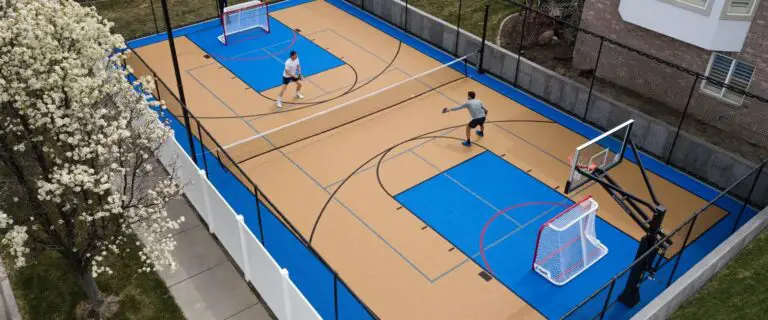How to make a pickleball rebounder – Step by Step Guide (2024)
Termed interchangeably as a ball machine or practice companion, a pickleball rebounder is a specialized training apparatus crafted to replicate the diverse shots and trajectories encountered in pickleball matches. It comprises a framework housing a responsive surface that propels the ball back to the player after each stroke. This setup enables players to hone their strokes, footwork, and overall techniques autonomously, eliminating the necessity for a playing partner or adversary. Lets have a look at how to make a pickleball rebounder.
Pickleball rebounders showcase a diversity of types and designs, each tailored to distinct preferences and training requirements. Among the prevalent variations are stationary rebounders, portable rebounders, and adjustable rebounders.
| Stationary Rebounders | Portable Rebounders | Adjustable Rebounders |
| Engineered as immobile structures, stationary rebounders furnish a consistent and unwavering bounce. Typically fashioned from resilient materials like steel or aluminium, these rebounders endure rigorous practice sessions effortlessly. Ideal for players with dedicated training spaces, they offer a robust and enduring setup. | Offering unparalleled mobility, portable rebounders enable players to effortlessly transport and set up their practice tools wherever they desire. Crafted with lightweight and often foldable designs, these rebounders, usually made of high-quality nylon or netting material, cater to players with space constraints or those who frequently practice in various locations. | Providing adaptability in the angle of the rebounding surface, adjustable rebounders empower players to mimic diverse shots and game scenarios. Equipped with features like adjustable legs or frames, these rebounders allow for customization, enabling players to replicate specific shots or practice responses to varying ball trajectories. Preferred by those aiming to replicate game-like scenarios for skill enhancement. |
How to make a pickleball rebounder
Follow the below-mentioned steps which can help you make a pickleball rebounder, have a look!
Step 1: Preparing the Workspace and Gathering Materials
Before embarking on the construction of your pickleball rebounder, the groundwork involves creating an environment conducive to precision and efficiency. Allocate a well-lit and spacious area, ensuring comfort and ease during the construction process. The success of your pickleball rebounder project hinges on the meticulous gathering of essential materials. This includes steel or aluminum pipes for the frame, robust plywood or strong plastic for the rebounding surface, as well as screws, bolts, nuts, netting or nylon fabric (if applicable), and paint or treatment for enhancing durability.
Critical to the structural integrity of your rebounder is the precision in measurements. Accurately align frame components with your desired rebounder size and dimensions. Establish a clear blueprint, maintain an organized workspace, and ensure the availability of the complete set of materials. This meticulous approach sets the stage for a seamless and successful construction. The following is the material and tools required to make a pickleball rebounder:
- Steel or Aluminum Pipes, are essential for constructing the frame, providing durability and stability.
- Plywood or Strong Plastic serves as the rebounding surface, ensuring a responsive bounce.
- Screws, Bolts, and Nuts: Crucial for assembly, securing the components in place.
- Netting or Nylon Fabric will be utilized for the rebounding surface in portable or adjustable rebounders, ensuring consistent bounces.
- Paint or Treatment offers durability and weather resistance to the rebounder.
- Measuring Tape and Ruler is required for Precise measurements and accurate construction.
- A saw or Pipe Cutter is essential for cutting the frame materials accurately.
- Drill and Drill Bits are required for creating holes and securely fixing screws in place.
- A screwdriver or Wrench is important for tightening bolts and nuts during assembly.
- Paintbrush or Spray Gun will be utilized for the application of paint or treatment, ensuring longevity.
Step 2: Make the Rebounder Frame
The pivotal foundation of your pickleball rebounder lies within its frame, serving as the cornerstone for stability and resilience. Initiating the frame construction involves following precise actions, ensuring stability and structural integrity.
- Cutting the Frame Components: Commence the frame assembly by meticulously cutting the steel or aluminum pipes to their designated lengths, aligning precisely with your predetermined measurements. Employ a saw or pipe cutter to achieve immaculate and precise cuts, guaranteeing the accuracy required for a robust frame structure.
- Assembling the Frame Structure: With all the components at hand, embark on connecting the pipes, employing screws, bolts, and nuts to fashion the frame structure. Each joint must boast a secure and steadfast connection, fortifying the rebounder to endure the forceful impact of the ball.
- Strengthening the Frame: Consider using the frame by integrating support beams or braces strategically. These additions, either positioned diagonally or horizontally, serve to augment the rebounder’s stability and resilience. Their presence minimizes any potential wobbling or displacement, ensuring a consistently reliable bounce during usage.
Step 3: Mount the Rebounding Surface
The rebounding surface stands as the pivotal area where the ball rebounds, demanding a reasonable selection of material and meticulous attachment to the frame for optimal Performance. Following are the mini steps that will help you mount the rebounding surface:
- Choosing the Appropriate Material: Selecting the suitable material for the rebounding surface holds paramount importance. Plywood or robust plastic are preferred choices, ensuring a resilient and consistent bounce. Cut the chosen material to snugly fit the dimensions of the frame, guaranteeing an even and secure placement.
- Attaching the Surface Material: For portable or adjustable rebounders necessitating netting or nylon fabric as the rebounding surface, a cautious attachment process is crucial. Employ screws, bolts, or suitable fasteners to affix the material meticulously to the frame. Pay close attention to stretching the material tautly, ensuring a uniform and predictable bounce trajectory.
Attaching the rebounding surface with precision and care not only assures a reliable rebound but also upholds the integrity of the rebounder, promising enhanced practice sessions tailored to your skill advancement.
Step 4: Finalizing and Tailor Rebounder
With the foundational structure and rebounding surface firmly in place, the culmination of your pickleball rebounder involves adding final touches and executing pivotal adjustments for an optimized training experience. The following are the final mini-steps:
- Applying Protective Finishes: To fortify the rebounder against weather elements and bolster its longevity, consider applying a weather-resistant treatment or outdoor-grade paint to the frame. This protective measure not only safeguards the structure but also augments its durability, ensuring sustained Performance over time.
- Adjusting for Optimal Performance: For adjustable rebounders, the ability to customize the rebounding surface angle plays a crucial role in refining your training sessions. Take advantage of this feature by experimenting with diverse angles, and simulating various shots and game scenarios.
This adaptability empowers you to tailor practice sessions, focusing on specific game aspects and honing your skills to perfection. The incorporation of protective finishes and precise adjustments not only elevates the rebounder’s resilience but also grants you the opportunity to personalize training sessions, facilitating targeted skill enhancement for an unparalleled pickleball practice experience.
Step 5: Assessing the Performance of Pickleball Rebounder
Upon completing the construction and fine-tuning of your pickleball rebounder, it’s imperative to conduct a comprehensive evaluation to ascertain its functionality and effectiveness. This testing phase marks the culmination of your efforts, guiding any final refinements before integrating the rebounder into your regular training regimen. The following are the mini steps:
- Conducting Practical Tests: Position yourself at an appropriate distance from the rebounder and engage in varied shots, focusing intently on refining your technique, footwork, and overall control. Assess the consistency and precision of the ball’s bounce, ensuring it aligns with your expectations and requirements.
- Analyzing Performance: Use this phase to fine-tune your shots, making subtle adjustments to optimize the rebounder’s functionality.
Step 6: Final Modifications
Utilize the insights gleaned from testing to implement any final modifications or enhancements deemed necessary. This iterative process ensures that your pickleball rebounder attains its utmost potential, aligning seamlessly with your training objectives.
By adhering to this step-by-step guide and meticulously evaluating the rebounder’s performance, you’re on the verge of integrating a custom-crafted training tool into your routine. Embrace the journey, exercise attention to detail, and relish the creation of a valuable asset bound to elevate your pickleball prowess.
FAQs
Why is a pickleball rebounder essential for practice?
A pickleball rebounder offers solo practice opportunities, allowing players to refine their skills independently. It simulates game scenarios, offering consistent and versatile training, which contributes significantly to skill enhancement.
What materials are necessary to build a pickleball rebounder?
Essential materials include steel or aluminum pipes for the frame, sturdy plywood or strong plastic for the rebounding surface, screws, bolts, nuts, netting or nylon fabric (if applicable), and paint or treatment for durability.
Can a pickleball rebounder cater to different skill levels?
A pickleball rebounder is versatile and adaptable. Its adjustable features allow players to customize training sessions, making it suitable for beginners looking to grasp basic techniques and advanced players aiming to refine specific shots.
How does a pickleball rebounder contribute to game improvement?
By providing consistent and predictable ball rebounds, a pickleball rebounder helps players develop muscle memory for various shots. This contributes to improved consistency and precision during actual gameplay, ultimately elevating a player’s performance on the court.






